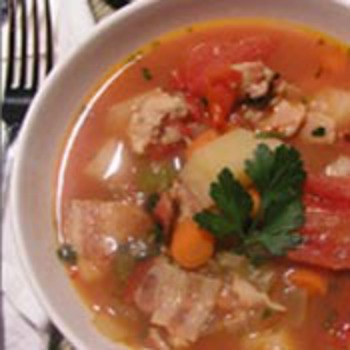New Yorker’s insist on tomatoes in their chowder and call it Manhattan clam chowder. Cookbook writer and chef James Beard (1903-1985) described Manhattan clam chowder as:
“. . . that rather horrendous soup called Manhattan clam chowder. . . resembles a vegetable soup soup that accidentally had some clams dumped into it.”
Connecticut chowder seems to be yet another version of the Manhattan-style clam chowder, made with tomatoes in place of milk.
Introduction of the Tomato – Tomato-based clam chowders came about with the new-found popularity of the tomato in the mid-1800s and the large population of Italians in New York and the Portuguese fishing communities of Rhode Island. By the 1930s, this tomato version had come to be called Manhattan clam chowder. Learn about Tomato Hints, Tips, and Information.
Manhattan Clam Chowder History:
Some historians say that Manhattan Clam Chowder was originally called Coney Island Clam Chowder and/or Fulton Market Clam Chowder. Both of these names were used in the 1890s.
Both of the below cookbooks, written by Alessandro Filippini and Charles Ranhofer, who both worked at the famous Delmonice’s Restaurant in New York at different times, were considered as most important cook books in modern cooking. Since nearly everything that Delmonic’s Restaurant served was widely imitated, it is certain that several New York upscale restaurants probably sold a version of tomato-based clam chowder, today known as Manhattan Clam Chowder.
1889 – Alessandro Filippini was Delmonico chef du maison from 1849 to 1863. Alessandro Filippini helped Lorenzo Delmonico guide Delmonico”s Restaurant to the height of culinary excellence. In 1889, Fillippini wrote his now famous cookbook called The Table: How to Buy Food, How to Cook It, and How to Serve It, which was written for the non-professional home cook. This is his recipe – word for word for tomato-based clam chowder:
Wash six fine, medium sized potatoes, peel and cut them into small dice-shaped pieces, wash again in fresh water, take them up with a skimmer; place them in a stewpan large enough to hold three quarts. Immediately add two quarts of cold water (not placing the pan on the fire until so mentioned.) Peel one medium sized, sound onion, chop it up very fine, and place it on a plate. Take a quarter of a bunch of well-washed parsley greens (suppressing the stalks), place it with the onions; wash well two stalks of soup celery, chop it up very fine, place it with the parsley and onions, and add all these in the stew pan. Place the pan on a brisk fire. Season with a light pinch of salt, adding at the same time a light tablespoonful of good butter. Let all cook until the potatoes are nearly done; eighteen minutes will be sufficient. Cut from a piece of fresh pork, CROSSWISE, one slice a third of an inch thick, then cut it in pieces a third of an inch square, fry, and reduce it in a pan on the hot stove for four minutes. Add it to the broth, add also three-quarters of a teaspoonful of branch dry thyme. Lightly scald four medium-sized tomatoes, peel and cut them into small pieces and add them to the preparation. Open and place in a bowl twenty-four medium-sized, fine, clams; pour into another bowl half of their juice. Place the clams on a wooden board, cut each one into four equal pieces, and immediately plunge them into the pan with the rest; gently mix so as to prevent burning at the bottom while boiling, for two minutes. Range the pan on the corner of the stove to keep warm. Season with a saltspoonful black pepper, one tablespoonful of Worchestershire sauce, gently stir the whole with a wooden spoon; break in two pilot crackers in small pieces stir a little again. Leave two minutes longer in the same position, but under on circumstances allow to boil. Pour into a hot soup-tureen, and serve.
1894 – Charles Ranhofer (1836-1899), the celebrated French chef at the famous Delmonico’s restaurant in New York from 1862 to 1896. In his 1894 edition of his cookbook The Epicurean: A Complete Treatise of Analytical & Practical Studies, has a recipe for a tomato-based clam chowder called Clam Chowder (Chowder de Lucines):
Clam Chowder (Chowder de Lucines) – Prepare a quarter of a pound of well chopped fat pork, a small bunch of parsley chopped not too fine, four ounces of chopped onions, one and a half quarts of potatoes cut in seven-sixteenth of an inch squares; two quarts of clams retaining all the juice possible; one quart of tomatoes peeled, pressed and cut in half inch squares. Put the fat pork into a saucepan, and when fried, add the onions to fry for one minute, then the potatoes, the clams and the tomatoes; should there not be sufficient moistening, pour in a little water and boil the whole until the potatoes are well done. Add five pilot crackers broken up into very small bits; one soup spoonful of thyme leaves, two ounces of butter, a very little pepper and salt to taste. This quantity will make four gallons, sufficient for sixty persons.
1939 – In February 1939, a bill was introduced by Assemblyman Seeder to the Maine legislature to make it a statutory and culinary offense to put tomatoes into chowder.


2 Responses to “Manhattan Clam Chowder History”
Joseph
What is the singular most dominant spice in Manhattan clam chowder?
raymond dragos
my brother owned a restaurant in nutley nj. he made the best seafood chowder. [ seafood meaning clams and whatever seafood he wanted ]. i remember the strong taste of oregano in it. you couldn’t stop at one bowl